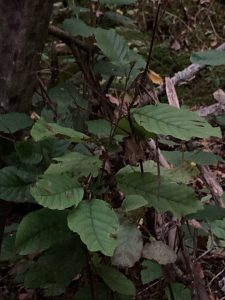
new growth stem with alternating simple broadleaves with entire wavy margins
On Wednesday, the 7th of October, I set off for my sit-spot, arriving at 6:10pm. I was there until 7:20pm, which allowed me to experience how quickly the temperature can drop these days. I took a few minutes to look around the rock peninsula to see what species I wanted to observe. I settled upon a leafy green plant towards the southern tip of the peninsula off the western bank that drew me in with its amount of new growth. I’m not one-hundred percent that the plant is spicebush, but, after hours I spent attempting to identify it, Lindera benzoin seems to share the most characteristics.
When observing, I first noted how the plant had a cluster of stems with broadleaves half the size of my palm. This cluster surrounded three trunks, whos’ leaves looked almost identical to the 1-2ft tall stems. Due to the similarities, I concluded that they were part of the same plant. The thicker stems/trunks were smooth and of various grey tones with marks every 1/2-1in. Towards the base of the stems, the bark was darker grey, but as it went upwards, lighter grey spots grew bigger and more numerous until the whole perimeter was of the lighter grey. The leaves on the newer growth were what I was able to most closely examine.
In the waning light, the contrast between the leaves and their veins was remarkable as they appeared deeply saturated in shades of green. Their oval shape with pointed tips and slightly wavy edges felt reminiscent of how I drew poison oak leaves when I was first attempting to capture their look.
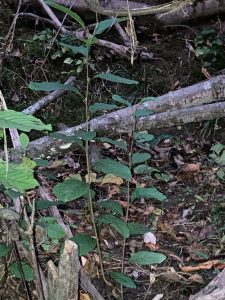
picture of new growth stem from farther away
Towards the end of my observation time, I noted that a broken trunk that had fallen upstream on the bank was, in fact, the branch on which one of the items (the berry and collection of twigs/duff) was part of. This was especially useful to note when attempting my identification.
When I started my identification process, I used an app on my phone, PictureThis, but I quickly knew that it would not be of much help, although it might help lead me in the right direction. So, I turned to the trusty internet and was much relieved to know that there were many different guides to help identify. The first two hours were spent learning differences in leaves, bark, twigs, etc… However, when observing a plant, I now know that my observations should use words like alternating versus opposite or whorled, simple versus compound with their leaflets, pinnately versus palmately, lobed versus unlobed, and the differences in margins.
Once armed with the terminology, I naively thought that my quest would quickly arrive upon its treasure. Instead of being quick, it was grueling to wade through all the possibilities to only find too many differences for the possibilities to even remain possible. Thankfully for me, Maryland’s Department of Natural Resources was able to throw me a lifeline in the form of a single picture with the words Spicebush, shrub, and red berries in fall below it. Quickly I turned to look for what characteristics this plant species might have that would be the same as my plant.
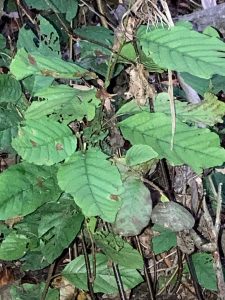
new growth leaves, but under flash
Their similar leaf patterns, both alternate with simple leaves, renewed my hope that the internet’s rabbit hole had stolen from me. As I examined what the internet could provide in pictures of spicebush berries, this hope grew bigger. However, it was almost extinguished when images of the bark did not generally match with my observations. In the end, Lindera benzoin is the most likely option for my plant to be identified as and I have gained a new appreciation for the plants at my spot. Although, I might rather not know what a plant is than try and identify it.
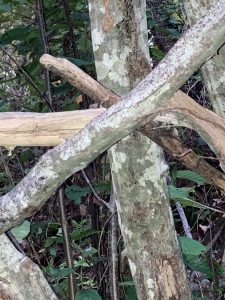
the bark that made me question everything
Spicebush is supposed to have a spicy odor once its leaves are crushed, but I have not seen if my plant’s leaves do. Often spicebush bark is grey-brown and has “light-colored lenticels”. My favorite fact I learned about this plant is that extracts from the plant have been used for a variety of different drugs.
Sources:
https://forestupdate.frec.vt.edu/content/dam/forestupdate_frec_vt_edu/real-estate/resources/presentations/treeid.pdf
Photo Wikimedia Commons
https://plants.usda.gov/plantguide/pdf/pg_libe3.pdf
https://dnr.maryland.gov/wildlife/Documents/TreeGuide_Common-Broadleaf.pdf
https://plants.ces.ncsu.edu/plants/lindera-benzoin/

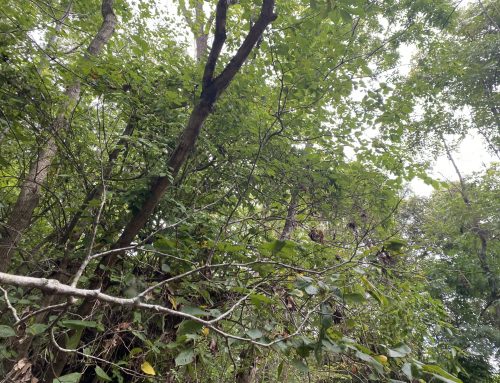
The way you described you’re journey in identifying the plant kept me on edge! It was easy to follow along with each new discovery you made regarding the identity of your plant. I had never heard of a spicebush before, but I am now curious about the smell it releases and what its purpose is.
At first I was unsure of what to expect reading this, but I really enjoyed it! I hadn’t considered how much work it would take in order to identify a plant species like that! As I read along with all the things you had to do to even attempt to identify it! I’d love to know what main sights/guides you used to identify local flora with!
Also I think it’s so neat that you contacted Maryland’s Department of Natural Resources in an attempt to identify! This blog has definitely made me think about the plants in my sit spot area, and wonder if I’ve taken them for granted.
Great way to discover a species of a plant! i really enjoyed reading your blog post about the thought process you went through throughout your post.
Wow I didn’t know that there were apps that were that easy to use for identification! That’s really cool because you could just find out new different species anytime, great find by the way. I personally find it really hard to identify plants so this is a nice way to identify things in our sit spot time.
I think its interesting how you chose what seemed like something really hard to identify and made it seem simple. Learning about this plant was really cool and I love your process